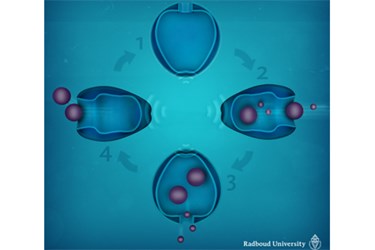"Nano Rockets" Could Magnetically Release Therapeutics
By Chuck Seegert, Ph.D.

Self-propelling “nano rockets” for therapeutic transport within the body have recently been shown to open and close under magnetic stimulation. These incredible nanovesicles could potentially drive themselves to a location then release therapy when signaled to do so.
Localized drug delivery with on-demand release of therapeutic agents is a major goal in medicine. By releasing a drug in a specific location, at a specific time, the ability to control the actions of a drug increases significantly. One major advantage to this approach is the patient’s body no longer needs to be flooded with huge doses of drugs in order to treat only a specific or local site. Systemic applications of drugs like this often lead to complications or side effects because tissues that don’t need the drug are exposed as well.
Researchers at Radboud University in the Netherlands have been pursuing this type of drug delivery device and have been making substantial steps forward, according to a recent press release. In 2012, the team published an article in Nature Chemistry that revealed a new nanovesicle design the team had been developing. This vesicle was capable of autonomous movement, which was generated by a chemical reaction occurring within the dimpled interior of the vesicle. Enclosed in the vesicle was a catalyst that reacted with hydrogen peroxide, breaking it down into water and oxygen, which in turn was expelled from the opening. The resulting propulsion led to the term “nano rocket.”
While, propulsion is interesting, the new nano rocket design required more features, like the controlled release of drugs or cargo once it had reached its destination. The team’s latest advance addresses this need. In a study published in Nature Communications, a method of opening and closing the vesicles using a magnetic field was discussed.
The vesicles are normally wrapped around the catalyst, leaving only a small opening for the jet of water and oxygen to shoot out. With the application of a magnetic field, however, the opening can be enlarged, which would allow drug particles to be released. What’s more, the degree the vesicle is opened is dependent on the strength of the magnetic field, according to the latest study. Starting at a level of 10 Tesla, the vesicle will begin to open and increase in a continuous fashion as the magnetic field goes up to 20 Tesla.
“Suppose you fill the vesicle with fuel and medicines, then you could transport the vesicle by creating a small opening and only allow the fuel to get out,” researcher Daniela Wilson said in the press release. “Then you could unload the remaining cargo at the destination.”
Currently the vesicle materials are unsuitable for use in the human body. Finding materials that behave similarly, while being safe for human use, will be a future focus for the team, according to the press release. The team would also like to find vesicles that react in a magnetic range of 3 Tesla or less, as this would allow them to be used clinically.
Using nanostructures to locally release therapeutics is a focus of many research groups. Recently, a team used nanoparticles in a Trojan Horse technique to get cancer cells to ingest the particles.
Image Credit: Radboud University
